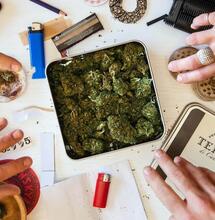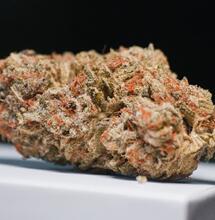How to Grow Blue Dream Cannabis?
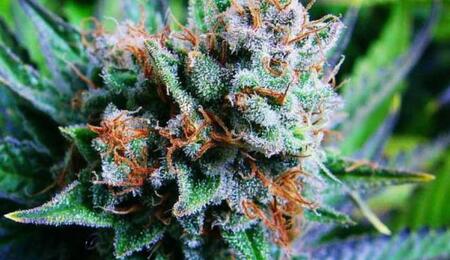
Blue Dream is a sativa-dominant hybrid strain, carrying the genetics of Blueberry cannabis and Haze. A pleasant daytime smoke, and one of the most famous cultivars engineered in sunny California, Blue Dream’s THC contents can range between 17% and 25%, while CBD is found in up to 2%. In this grow guide, we’ll start with a brief introduction to the Blue Dream cannabis strain, its medical uses, effects and growing difficulties, before we continue with practical advice and tips on how to cultivate this cannabis strain at home.
Introduction to the Blue Dream Cannabis Strain
Cannabis users love the Blue Dream strain as it simultaneously energizes and offers whole-body relaxation. It’s easy to understand why both medical and recreational consumers are after this type of weed. With satisfyingly high levels of THC, spiced with CBD, it’s the perfect strain to help treat various pains and ailments. For those who smoke for the fun of it, it’s a happy strain, the high of which culminates into euphoria and you don’t feel knocked out. That is if you don’t overdo it.
Genetics: Blue Dream cannabis is the result of crossing Super Silver Haze and Blueberry. Some phenotypes of the Blue Dream strain can weigh a bit more on the indica side, however, most varieties retain the subtle balance of 60% Sativa and 40% Indica.
Taste and flavor: Blue Dream cannabis has a sweet berry fragrance, which is to be expected given its genetic makeup. First comes the super sweet smell, then the taste. The captivating hint of berries is noticeable all the way. For users who are not quite fond of fruity flavors, vaporizing instead of smoking may be the preferred way to consume Blue Dream. Vaporizing will filter the extra sweetness typical for this strain.
Terpenes: Blue Dream cannabis is rich in myrcene which reinforces the strain’s sedative properties. It also contains pinene and caryophyllene, to which we can attribute the occasionally spicy trace left by smoking this type of weed.
Effects: Thanks to its sativa heritage, Blue Dream cannabis users will feel happily energized. Smoking also follows a complete relaxation of the body, which is all thanks to the indica genes mix. The more you consume Blue Dreams, the more of the couch lock feeling that may come after that. Anyhow, it takes a lot of toking, at very short intervals, to get glued on the sofa. Smoking effects from Blue Dream can last for up to three hours; smoking at three-hour intervals can help avoid couch lock.
Medical uses: Blue Dream cannabis strain works as a popular daytime medicine to treat pain, depression, nausea, and similar conditions that can be soothed with a THC-rich marijuana.
Side effects: Those less tolerant of strong THC strains can experience rapid heartbeats and - in rare cases - anxiety or slight paranoia. If you think that Blue Dream is not working so well for you, opt for other cannabis strains with less THC concentration.
Lifestyle: Toking any time of the day for any occasion is OK, as this really is a great smoke that will not escort you out too early to the bedroom. Use Blue Dream weed as a relaxant in a smoke session after work or share a spliff in the evening with friends while you wait for that pizza order. Blue Dream has versatile uses and will fit every smoker’s lifestyle.
Growing difficulty: One of the best things about growing Blue Dream cannabis is that it’s easy to cultivate strain! It is a suitable cannabis strain for beginner-level growers, and even if mistakes are made in the process, you can still get something out of the harvest. Growing Blue Dream cannabis strain outdoors in climates similar to its native California is pretty straightforward. Pests might be an issue, but you can take various protective actions in advance. Avoid cultivating Blue Dream plants outdoors where the climate is unpredictable, as this will not soothe this cannabis strain so much.
Flowering and yield: For the best possible harvest, wait for 9-10 weeks for Blue Dream cannabis plants to flower. Prepare for an abundant yield, which can range between 15-20 ounces per square meter indoors and sometimes over 20 ounces if grown outdoors.
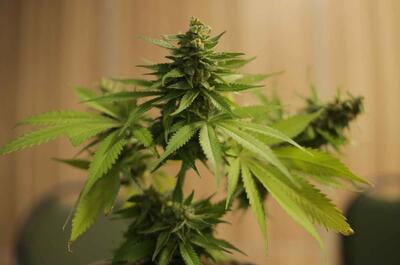
How to Grow Blue Dream Marijuana Indoors?
Blue Dream cannabis is ideally grown outdoors. However, if you don’t live in a subtropical or Mediterranean-like climate, taking care of your Blue Dream crops indoors is the better option. Growing this cannabis strain will require a big grow room or spacious tent to accommodate the rather large and chunky plants typical for Blue Dream. You will also need metal stalks at varying lengths with hooks to stalk each plant, and 5-gallon pots to transplant them a month after seeding.
Blue Dream cannabis easily adapts to indoor environments. But for a strain that tends to grow taller than people (it can quickly pass a six-foot mark), it’s more than recommended to regularly schedule topping and training in your Blue Dream grow calendar. After transplanting the plants to larger pots, regularly check for pruning and training. Indoor Blue Dream plants may require a somewhat more aggressive approach to topping and training.
Staking Blue Dream plants is also a good idea since it will help support the trunk, keeping a straight position. The Blue Dream cannabis strain naturally grows tall and dense, therefore staking prevents the plants from leaning over or falling from the main stem. When you proceed with staking, make sure that you position each stake upright, preferably to the midpoint of the main stem.
If you plan on growing Blue Dream cannabis plants for multiple seasons in a row, it’s good to keep a diary as a reference when you perform each of these tasks.
What Are the Nutrient Preferences for Blue Dream Plants?
Unsurprisingly, Blue Dream can be a hungry beast, demanding a lot of nutrients during vegetation and flowering. Like other cannabis plants, Blue Dream needs its fair share of the critical trio of nutrients nitrogen, phosphorus, and potassium. It also needs nutrient solutions that contain calcium, magnesium, and sulfur. Other micronutrients such as copper, cobalt, silicon, manganese, iron, boron, and zinc can also be added in the form of readily available grow supplements.
Excess feeding with nitrogen will not cause harm on the Blue Dream variety. It would be a mistake with many other marijuana strains to keep on supplementing nitrogen past the point plants reach flowering, but with Blue Dream, it’s not so much of a big deal. Blue Dream plants can consume vast quantities of this nutrient, and it will not negatively impact the yield. In fact, Blue Dream plants can devour twice as much nitrogen during growing compared to other cannabis strains.
The amount of nutrients needed for Blue Dream plants would also depend on the quality of the soil used. Purchasing high-quality soils where to plant Blue Dream cannabis will reduce any urgency of dispensing extra nutrients. Some growers take additional measures to improve the plants’ nutrient uptake from the soil. Using liquid seaweed and molasses mixed with reverse osmosis (RO) water while watering during vegetation can help maximize nutrient absorption. Or you can also create “fungal roots” by adding mycorrhizae to the seeds, which will boost the ability of the root system to detect nutrients in the soil and help the plant produce more carbohydrates.
How to Optimize pH Levels?
When nourishing your Blue Dream cannabis plants, it’s good to test the water’s pH. Soil pH basically affects the quantity of nutrients and chemicals soluble in soil water, and with that, how much food is available to the plant organism. Testing pH values can help growers determine if they are dispensing sufficient amounts of food to the crops. Whether growing in soil, the pH should remain between 6.5 and 7.0. In a hydroponic setting, the correct value ranges between 5.5 and 6.5 for Blue Dream cannabis.
Specialized solutions sold in grow shops can help adjust the pH in the growing medium. Information on how much of the solution should be used per gallon of water to adjust pH environment will usually be featured on the package. This can save your crops from starving, and as already mentioned, with Blue Dream cannabis strain, it’s all about not letting your plants starve.
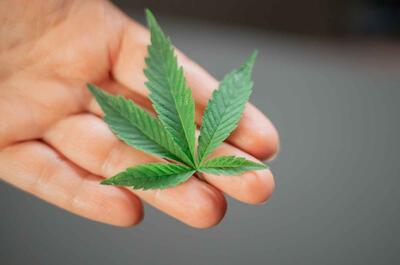
Do Pests Pose a Risk for Blue Dream Cannabis Plants?
Some cannabis strains are well resistant to pests and you don’t have to worry a great deal about it. However, Blue Dream cannabis will require timely reactions and preferably taking some measures in advance, especially for growing this strain outdoors.
There are several strategies that you can take to protect your Blue Dream cannabis plants from uninvited guests in your garden:
- Use readily-available remedies, which you can buy in-store or online, billed to repel fungi, insects, mites, or other critters that may come after your plants.
- Introduce companion plants around your cannabis garden to protect Blue Dream cannabis. The pungent smell of certain plants such as lavender will deter many unwanted insects. Planting basil or mint can protect against aphids and beetles. Plant geranium if caterpillars or worms are the issue.
- Introduce benevolent insects to protect against harmful ones. For example, ladybugs hunt red spider mites, should this type of mites appear in your outdoor garden.
- Use garlic as a natural fungicide to protect against fungal infestations. Tonify the soil with natural concoctions and other supplements to boost the health of your cannabis plants.
How to Regulate Temperature and Humidity?
Ideally, growers will cultivate Blue Dream in temperatures between 65-85 degrees Fahrenheit. When the cannabis plants are just seedlings, the optimal range should be around 75 degrees Fahrenheit (plus or minus two degrees should be acceptable).
A matching humidity range for seedlings would be between 30-50%. Then, a month into growing, start to slightly increase room humidity, to somewhere around 55%.
When plants enter the flowering stage, it’s time to increase the temperature. Blue Dream cannabis likes it when it’s warm, so at this point, keeping the temperature at around 82 degrees Fahrenheit (plus or minus two degrees) is recommended for indoor grow rooms. At the same time, gradually lower down the humidity level. It can be simply fixed with a dehumidifier: each week, reduce by a few percent until you are in the 30-40% range.
What’s the Proper Light Setup for Blue Dream Weed Strain?
Blue Dream cannabis plants outdoors will benefit from direct exposure to natural sunlight, given that they are growing in a climate appropriate for them.
Indoors, here’s how you should proceed:
- Seedlings: 16-24 hours of light (clones are happy with 18-24 hours of light a day)
- Vegetation stage: 18-24 light arrangement
- Flowering stage: switch to 12-12 light and dark regiment
This light setup should promote vigorous growth of Blue Dream cannabis plants. Both LED grow lights and HPS lamps are good options. Exposure to blue light wavelengths during vegetation will help promote chlorophyll B synthesis, which plants need for healthy photosynthesis and good structural development.
Gently Handle the Fruits of Your Hard Labor
After more than two months of tending and caring to these beautiful plants, Blue Dream cannabis will grow big and bushy, forming prominent bud sites. Pluck the flowers carefully and use at least a week of drying and curing before storing the plant material. In case you are willing to wait a couple of more days than that, or even weeks, you will be able to enjoy a bit stronger and more flavorsome smoke. The weed is yours and it’s up to you!
Happy growing!
More cannabis grow guides from Soft Secrets:
- How to Grow Do Si Dos Cannabis?
- How to Grow Wedding Cake Weed Strain?
- How to Grow Blueberry Cannabis and Get the Best Yield Outdoor?
Last updated on September 5, 2025




